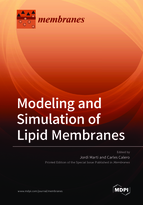Modeling and Simulation of Lipid Membranes
A special issue of Membranes (ISSN 2077-0375). This special issue belongs to the section "Membrane Physics and Theory".
Deadline for manuscript submissions: closed (15 December 2021) | Viewed by 27482
Special Issue Editors
Interests: modeling and simulation of cell membranes; membrane structure and dynamics; interactions of proteins, drugs, and small molecules with biomembranes; free-energy landscapes in complex systems; water and aqueous solutions; proton transfer in aqueous environments and under restricted geometries; helium nucleation inside blankets of nuclear fusion reactors
Interests: fluids under confinement; water at biological interfaces; modelling and simulation of cell membranes; colloidal aggregation; micro- and nanoswimmers; active particles
Special Issue Information
Dear Colleagues,
Membranes are highly complex, dynamic structures that are absolutely fundamental to life, forming the most relevant interface in biology. They are composed of a wide variety of elements, such as lipids, sterols, and proteins, each of them playing a key role in membrane function. The knowledge of the structure, energetics, and dynamic properties of biomembranes has become one of most important challenges in biophysics. In order to advance our understanding of membrane properties and, beyond, to gain knowledge on diseases such as many cancers or the most recent SARS-CoV-2, it is also crucial to acquire information on the interaction of pathogens with the cell, since it will undeniably be through the cell membrane.
The use of different computational techniques and modeling approaches, combining computer simulations with available experimental data, will provide such information and let us learn at different levels—from atomic resolution to coarse-grained models—unknown details about the microscopic interactions that play a role in membrane structure and dynamics.
This Special Issue aims to gather new key contributions to the field and also give an overview about the connection between experiments and computer simulations, addressing fundamental aspects and applied research in biological membranes, with particular attention paid to the applications of modeling and simulation to biomedicine.
Prof. Dr. Jordi Marti
Dr. Carles Calero
Guest Editors
Manuscript Submission Information
Manuscripts should be submitted online at www.mdpi.com by registering and logging in to this website. Once you are registered, click here to go to the submission form. Manuscripts can be submitted until the deadline. All submissions that pass pre-check are peer-reviewed. Accepted papers will be published continuously in the journal (as soon as accepted) and will be listed together on the special issue website. Research articles, review articles as well as short communications are invited. For planned papers, a title and short abstract (about 100 words) can be sent to the Editorial Office for announcement on this website.
Submitted manuscripts should not have been published previously, nor be under consideration for publication elsewhere (except conference proceedings papers). All manuscripts are thoroughly refereed through a single-blind peer-review process. A guide for authors and other relevant information for submission of manuscripts is available on the Instructions for Authors page. Membranes is an international peer-reviewed open access monthly journal published by MDPI.
Please visit the Instructions for Authors page before submitting a manuscript. The Article Processing Charge (APC) for publication in this open access journal is 2700 CHF (Swiss Francs). Submitted papers should be well formatted and use good English. Authors may use MDPI's English editing service prior to publication or during author revisions.
Keywords
- membrane modeling and composition
- computer simulation of biomembranes
- membrane structure
- membrane dynamics
- lipids and cholesterol
- lipid dynamics and rafts
- free-energy landscapes in biomembranes
- membrane–drug interactions
- membrane–protein interactions
- membrane–small-molecule interactions
- bacterial membranes
- biomedicine








